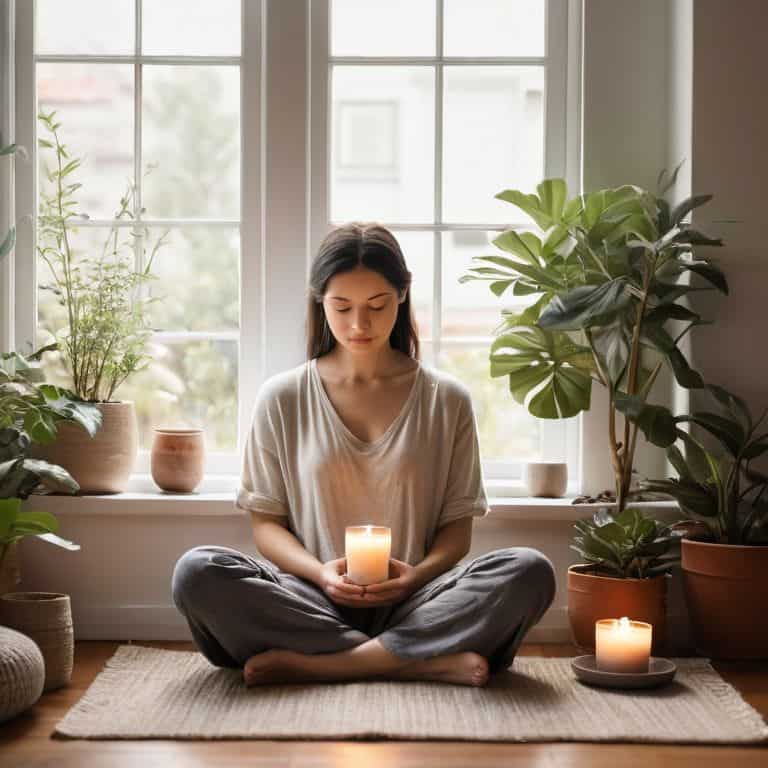I still remember the days when I thought mindfulness for busy people was just a luxury I couldn’t afford. As a former digital marketer, I was always “on” and constantly stressed, but I’ve since learned that this mindset was not only unsustainable, but also a major contributor to my burnout. The common myth that mindfulness is only for those with ample free time is not only frustrating, but also untrue. In reality, mindfulness is a powerful tool that can be practiced in just a few minutes a day, making it accessible to even the busiest of individuals.
As someone who has been in your shoes, I want to assure you that there is a better way to live and work. In this article, I’ll share practical tips and strategies for incorporating mindfulness into your daily routine, even when you’re short on time. You’ll learn how to prioritize your well-being, reduce stress, and increase productivity, all while maintaining a busy schedule. My goal is to provide you with honest and actionable advice, not just platitudes or vague promises. By the end of this guide, you’ll have a clear understanding of how to make mindfulness a sustainable part of your lifestyle, and how to reap its many benefits, even in the midst of chaos.
Table of Contents
Guide Overview: What You'll Need

Total Time: 10 minutes to 1 hour daily
Estimated Cost: free – $20
Difficulty Level: Easy
Tools Required
- Smartphone (with mindfulness app)
- Comfortable cushion or chair (for sitting meditation)
Supplies & Materials
- Guided meditation audio (optional)
- Mindfulness journal (for tracking progress)
Step-by-Step Instructions
- 1. First, let’s start by setting the foundation for our mindfulness practice, which is to create a quiet and comfortable space where you can sit and breathe without distractions. This could be a corner in your home, a outdoor spot, or even your car during your lunch break. The key is to find a place where you can sit comfortably and focus on your breath without interruptions.
- 2. Next, I want you to commit to a regular mindfulness practice, even if it’s just 5-10 minutes a day. This could be first thing in the morning, during your lunch break, or right before bed. Consistency is key when it comes to developing a mindfulness habit, so try to schedule it in your calendar and treat it as non-negotiable time for yourself.
- 3. Now, let’s talk about the actual mindfulness practice. To start, find a comfortable seated position with your back straight, feet planted firmly on the ground, and hands placed gently on your lap. Close your eyes and take a deep breath in through your nose, filling your lungs completely, and then exhale slowly through your mouth. As you breathe, focus on the sensation of the air moving in and out of your body, and try to let go of any thoughts or distractions. Remember, the goal is not to achieve a completely blank mind, but rather to cultivate awareness and presence in the moment.
- 4. As you continue to breathe, bring your attention to your body, starting from your toes and moving up to the top of your head. As you focus on each area, release any tension or discomfort, and allow yourself to relax and let go. This is a great opportunity to practice self-compassion and acknowledge any areas of your body that may be holding stress or tension.
- 5. Next, I want you to try a body scan meditation, where you focus on each part of your body, starting from your toes and moving up to the top of your head. As you focus on each area, notice any sensations, feelings, or thoughts without judgment, and allow yourself to release any tension or discomfort. This can help you cultivate a greater sense of awareness and connection to your body, and can be a powerful tool for managing stress and anxiety.
- 6. Another important aspect of mindfulness is mindful movement, which can help you cultivate a greater sense of awareness and presence in your daily activities. This could be as simple as paying attention to your breath while you walk, or focusing on the sensations in your feet as you stand. Try to incorporate mindful movement into your daily routine, whether it’s during your commute, while you’re doing chores, or during your exercise routine.
- 7. Finally, I want to encourage you to track your progress and reflect on your experiences. This could be as simple as keeping a mindfulness journal, where you write down your thoughts, feelings, and insights after each practice. Reflecting on your experiences can help you identify patterns and areas for growth, and can provide a sense of accountability and motivation to continue your mindfulness practice. Remember, the goal is not to achieve perfection, but rather to cultivate a greater sense of awareness, compassion, and kindness towards yourself and others.
Mindfulness for Busy People

As I guide my clients through their journey to a more balanced life, I always emphasize the importance of morning mindfulness routines. Starting your day with a few minutes of _silent reflection_ can set the tone for a more focused and productive day. It’s not about adding another task to your already packed schedule, but about creating a sense of calm and clarity that will help you navigate the chaos.
One of the simplest yet most effective ways to reduce stress at work is by incorporating _mindful breathing exercises_ into your daily routine. By taking a few deep breaths and focusing on the sensation of the air moving in and out of your body, you can calm your mind and reduce feelings of anxiety. This technique can be practiced anywhere, at any time, making it a great tool for busy individuals.
To make mindfulness a sustainable part of your daily life, try to bring increasing focus with meditation into your daily activities. This can be as simple as paying attention to your senses while eating or walking, or by practicing _simple mindfulness for beginners_ exercises during your daily commute. By doing so, you’ll be able to cultivate a greater sense of awareness and calm, even in the midst of a busy and demanding schedule.
Morning Mindfulness Routines to Boost Energy
As I’ve learned from my own journey with burnout, starting the day with mindfulness can be a game-changer. For busy individuals, incorporating a morning mindfulness routine can boost energy and set a positive tone for the day. I recommend beginning with simple, 5-10 minute practices such as deep breathing exercises, body scan meditation, or guided visualization. These activities help calm the mind, increase oxygen flow, and prepare the body for the day ahead.
By committing to a morning mindfulness routine, you’ll find that you’re more focused, resilient, and better equipped to handle the demands of your busy schedule. I like to color-code my digital calendar to ensure I prioritize these non-negotiable moments of self-care, and I encourage you to do the same. Even the smallest moments of mindfulness can have a profound impact on your overall well-being and energy levels.
Simple Mindful Breathing Exercises to Reduce Stress
As I guide my clients through burnout recovery, I’ve seen the profound impact of simple mindful breathing exercises. One technique I recommend is the 4-7-8 method: breathe in through your nose for a count of 4, hold for 7, and exhale through your mouth for 8. This helps calm the nervous system and reduce stress. Even just a few minutes a day can make a significant difference.
I also suggest incorporating box breathing into your daily routine: inhale for 4 counts, hold for 4, exhale for 4, and hold again for 4. This balanced rhythm can help quiet the mind and bring a sense of clarity. Remember, the goal isn’t to achieve a specific state, but to cultivate awareness and kindness towards yourself in each moment.
Mindful Momentum: 5 Essential Tips for Busy Lives
- Start small: begin with 5-minute mindfulness sessions to anchor your day
- Schedule mindfulness: treat it as non-negotiable self-care, just like brushing your teeth
- Practice mindful movement: incorporate activities like yoga or walking to reduce stress
- Use mindful reminders: place sticky notes or set phone reminders to breathe and stay present
- Prioritize digital detox: establish device-free zones and times to reduce digital overwhelm
Key Takeaways for a More Mindful You
I’ve found that incorporating short, daily mindfulness practices can significantly reduce feelings of burnout and increase productivity, even on the most chaotic of days
By committing to just a few minutes of mindful breathing exercises each morning, you can set yourself up for a day of clarity and focus, rather than stress and overwhelm
Remember, mindfulness isn’t a one-size-fits-all solution – it’s about experimenting with different techniques, such as restorative yoga or silent hikes, to find what works best for your unique lifestyle and needs
Embracing Mindfulness in Chaos
Mindfulness isn’t about finding an extra hour in your day; it’s about being fully present in the hours you already have, so you can breathe, belong, and thrive, not just exist.
Gabriela Rossi
Embracing Mindfulness for a Sustainable Career

As we’ve explored in this guide, incorporating mindfulness into your daily routine can have a profound impact on your overall well-being and productivity. From morning mindfulness routines to simple mindful breathing exercises, these practices can help you stay focused, reduce stress, and boost your energy levels. By prioritizing mindfulness, you can break free from the cycle of burnout and cultivate a more sustainable approach to your career. Remember, it’s all about making small, intentional changes that add up over time, rather than trying to overhaul your entire lifestyle at once.
As you embark on this journey, I want to leave you with a final thought: you are capable of creating a career that nourishes your mind, body, and soul. It’s time to redefine what success means to you and make self-care a non-negotiable part of your daily routine. By doing so, you’ll not only improve your own well-being but also become a more resilient, creative, and inspiring force in your industry. So, take a deep breath, be gentle with yourself, and trust that the path ahead will unfold with clarity and purpose.
Frequently Asked Questions
How can I incorporate mindfulness into my daily routine when I already feel like I'm running behind schedule?
I totally get it – feeling behind schedule can be overwhelming. Start small by incorporating one mindful moment into your daily routine, like taking 5 deep breaths during your morning coffee or noticing your senses while brushing your teeth. These tiny pauses can be a great starting point to bring more mindfulness into your busy life.
What are some mindfulness exercises that can be done in a short amount of time, like during a coffee break?
During a coffee break, try a 4-7-8 breathing exercise: inhale for 4 seconds, hold for 7, and exhale for 8. Or, take a 5-minute mindful walk, noticing your footsteps and surroundings. These quick exercises can calm your mind and refresh your focus, helping you return to work with renewed energy and clarity.
Can mindfulness really help reduce stress and increase productivity, or is it just a trendy concept with no real benefits?
I’ve seen it firsthand – mindfulness can be a total game-changer for reducing stress and boosting productivity. By incorporating simple practices into your daily routine, you can calm your mind, focus on what matters, and achieve more with less effort. It’s not just a trend; it’s a proven approach to sustainable well-being.
